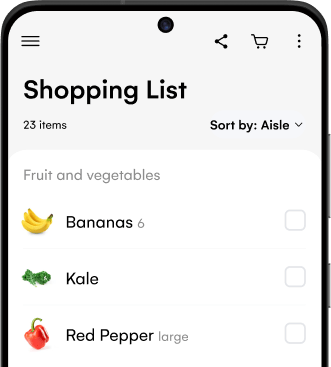With all these different types of cooking oils available nowadays, choosing the right one can be a little overwhelming. What will make your life easier is knowing the smoke points of different cooking oils.
What’s a smoke point and why it’s important
The smoke point of oil is the temperature at which the oil stops simmering, starts breaking down and producing smoke. If the oil is heated beyond its smoke point, the fats in it start to break down. This gives your food that distinct burnt aroma.
Analyse nutritional information for any recipe

So, if you’re not a big fan of burning your dinner and you like clean lines and straightforward information – you’re in the right place! With this smoke point table we’ve cooked for you, you’ll become a master chef in no time!
| Type of oil | Temperature in °C | Temperature in °F | Level of heat | Use |
| Avocado oil (refined) | 270 | 520 | High | Frying, stir-frying, broiling |
| Sunflower oil (refined) | 232 | 450 | High | Frying, stir-frying, broiling |
| Peanut oil (refined) | 226 | 450 | High | Frying, stir-frying, broiling |
| Canola (rapeseed) oil (refined) | 204-246 | 400-475 | High | Frying, stir-frying, broiling |
| Coconut oil (refined) | 204-232 | 400-450 | High | Frying, stir-frying, broiling |
| Grapeseed oil (refined) | 198-215 | 390-420 | Medium | Sautéing and baking |
| Sesame oil (refined) | 210 | 410 | Medium | Sautéing and baking |
| Avocado oil (unrefined) | 176-204 | 350-400 | Medium | Sautéing and baking |
| EVOO (unrefined) | 162-204 | 325-400 | Medium | Sautéing and baking |
| Vegetable oil (refined) | 204 | 400 | Medium | Sautéing and baking |
| Coconut oil (unrefined) | 176-193 | 350-380 | Low | Low heat cooking and sautéing |
| Sesame oil (unrefined) | 176 | 350 | Low | Low heat cooking and sautéing |
| Sunflower oil (unrefined) | 160 | 320 | Low | Low heat cooking and sautéing |
| Peanut oil (unrefined) | 160 | 320 | Low | Low heat cooking and sautéing |
| Almond oil (unrefined) | 107 | 225 | No heat | Dressing of already cooked or raw foods |
| Flaxseed oil (unrefined) | 107 | 225 | No heat | Dressing of already cooked or raw foods |
Each oil in the table is defined either as refined or unrefined. Knowing the difference and how it affects the smoke point can also be extremely helpful when cooking.

Refined oils
These are the cooking oils that undergo different stages of processing. They tend to have a more neutral taste and a higher smoke point. Because of that, these types of oils are more stable for storage and versatile. The table lists the smoke point of avocado oil at 270°C (520°F). It means that avocado oil can be used for techniques that require higher temperatures, such as frying and stir-frying. Additionally, the smoke point of vegetable oil is 204 °C (400°F) and it’s best used for baking. So, if you’re craving some delicious blueberry muffins, we’ve got you covered!
Save time on grocery shopping

Unrefined oils
On the other hand, unrefined oils are only filtered to remove impurities. These types of oils are more likely to retain their natural flavors and aromas. But that also makes their smoke point lower and shortens the list of cooking techniques they can be used for. The smoke point of extra virgin olive oil is 204°C (400°F). Because of that, olive oil is perfect for sautéing vegetables, but not so great for frying.
Our other conversion tables
Provided underneath are diverse conversion charts aimed at helping you master cooking skills.
